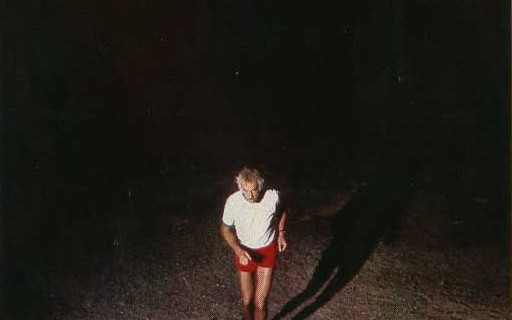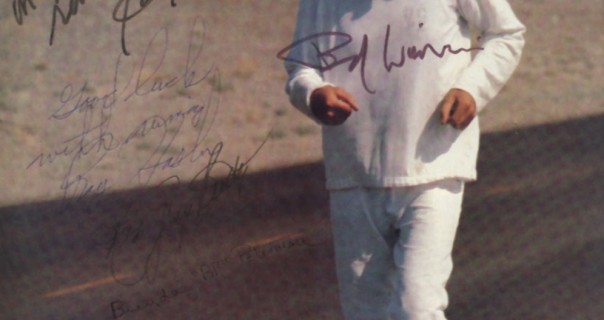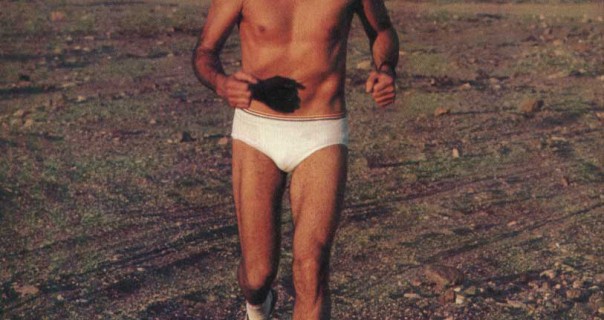“All in all, it’s just another brick in the wall…”
-Pink Floyd
Ask any runner about preparing for the 26.2 mile grind of a marathon, and sooner or later-usually sooner-you’ll hear about “The Wall.”
It is a truly fearsome place, where legs turn to melting jello and breath comes in short, gasping gulps. It is a legendary place, usually encountered around mile 20, where the flesh weakens, the spirit sags and the will drains away into a little puddle on the hard, hard ground. All hyperbole aside, there is probably nothing as feared, or misunderstood, by the novice marathoner as the 20-mile wall, the point where it is written that a person runs out of steam.
What is The Wall, anyway?
The modern science of running mechanics has stalked and, if studies are to be believed, captured The Wall. Jeff Galloway, in his 1984 classic book “Galloway’s Book on Running,” breaks the 20-mile barrier down into two specific physiological causes.
The first involves glycogen, one of our basic fuels stored in muscle tissue. Glycogen, says Galloway, is predominately a short-range fuel. Glycogen stores, even in a fit person, will only get us…20 miles. When we need endurance, our body should be burning fat; even a skinny person has about 600 miles of fat fuel. There’s a catch (isn’t there always?): fat can only be burned aerobically, in the presence of oxygen.
“When you run faster than you’ve trained, or farther,” Galloway writes. “You overwhelm the muscles.”
The precious glycogen is burned, waste products and fatigue poisons build up the muscles faster than they can be eliminated, and you hit The Wall.
A second factor, he adds, is that many very popular marathon training regimens call for the longest run to be 20 miles. That last 6.2 miles is uncharted territory. If you were to look at a map of the marathon route, the last six miles would have no details whatsoever-just the image of a fearsome-looking beast and the inscription, “Here Be Dragons.”
“So if you extend your long run to 26 miles or more,” Galloway writes, “and run the race pace you’ve trained for, you can avoid encountering, much less hitting, The Wall.”
Simple, reasonable explanations. But do they really answer the entire question, or only a small part?
I have some thoughts on the matter, but I need to give you a little background first.
A few years ago, after a wild day of windsurfing, pizza and beer, my friends and I created what we laughingly referred to as the list, 13 athletic endeavors that could kill you. In the time that followed, I decided to do all 13 things (chronicled in my book, “Over the Edge: A Regular Guy’s Odyssey in Extreme Sports”), which involved morphing myself from a seriously overweight couch potato to something resembling an athlete. Some of the items on the purely arbitrary list turned out to be easy (rock climbing), some terrifying (cave diving), some (climbing Mt. McKinley) harder than I had ever imagined.
Early on in the process, I was lucky enough to hook up with Steve Ilg, author of “The Outdoor Athlete” and listed by numerous publications as one of the best personal trainers in America. When I first met with Ilg in his small, dusty office on a back street in Santa Fe, he struck me as more of a shaman than a coach. I wanted to talk to him about training regimens; how far should I be running; how much weight should I be lifting. That was important, he said gently, but not nearly as important as what was in my head.
Through Ilg, I learned (somewhat lurchingly, I have to confess) that all athletic endeavors have a physical and a mental component. Imagine each of these components as lines on a graph. When a person first starts training, the “physical” line spikes up faster than the “mental” line-as we start training, there’s more physical than mental effort required.
As we push ourselves harder, as we make the decision to test our own personal limits, that mental line-the mental effort necessary to accomplish our goals-increases faster than the physical line.
There will come a point, said Steve Ilg the Shaman, where your success or failure, possibly even your life, will hinge not on the physical, but solely on the mental.
What does this have to do with The Wall? I think for most of us, the 26.2 miles of the marathon represents the first place where the physical and mental lines on the graph converge. Yes, the physical effort of a marathon is tremendous, but it is the mental effort that will carry you across the finish line.
Unfortunately, we tend to approach mental training the same way we approach physical training-how much do I lift; how far do I run? There are numerous books these days on mental preparation for various sports. The bulk of them tend to offer sort of a brain prescription: two sets of visualization, three sets of relaxation, a quick two laps of positive thoughts and-viola!-instant sports nirvana.
Were that it was only so easy! As I moved through my list and beyond I came to see that the closer we came to our own personal edges, the more we moved away from the physical and onto a mental “landscape.” That landscape was and is fraught with dangers, traps waiting for the unknowing. It is the place where cause and effect start breaking down; where time looses its grip; a place where chaos reigns supreme.
I first caught a hint of this landscape in Death Valley. I was biking and running alongside competitors in the Hi-Tec Badwater 135, a 135-mile running race from Badwater, the lowest point in America, over two mountain ranges to the portals of Mt. Whitney, the highest point in America. Temperatures can range from 125 degrees down to below freezing.
It was morning, and I was alongside a rodeo cowboy turned successful banker, who did ultra-endurance events the way normal people do 5-K runs. The temperature was just cracking 100; we’d been running the flats and walking the climbs. As we walked, he was explaining to me the basics of the mental landscape.
“In an event like this,” he said, “your mind goes to strange places. You’ll experience every emotion, from the highest highs to the lowest lows.”
And then he told me about the dragon. And what an amazing dragon it was! Scales like roofing tiles; eyes blazing yellow fire. It was, he said, a dragon created of all a person’s fears and doubts and fatigue and pain. As the temperature soared, the banker described the dragon; how it came at a person’s lowest ebb, feeding on all the pain and suffering, every thought of failure, every couldn’t, wouldn’t, shouldn’t.
As he talked, the great convection oven that is Death Valley sucked the moisture from my skin, leaving only a fine, white dusting of salt.
What do you do, I insisted.
“Why, nothing, of course,” he said. “Keep running.”
To tell the truth, in my two marathons, I’ve never found a trace of The Wall. Mile 20 was no more-or less-painful than mile 18 or mile 23. Certainly training had something to do with not hitting The Wall. But more importantly, the lessons I learned at the edges of the known universe have served me well. I have found my dragon on the cold ice of Alaska, and on the sides of Big Mountains; once even within sight of the lights of Malibu, after all night on a trail and a full day left to travel. He’s there, though, always waiting. If you go far enough, there’s always The Wall.
The old rodeo cowboy told the truth-the mind will go to strange places, and, despite how easy those relaxation and focusing techniques seemed in your bedroom, you won’t have much control. Instead, here are some thoughts that have helped me, and can help you.
- Accept that a portion of your race will be run on a mental landscape, and that it can be a scary place. It’s a landscape littered with your own failures and successes, your pains and your losses. It’s home to mythical creatures and places of legend, and your journey will be uniquely your own.
- Understand that you may be beset by storms of powerful emotions-exhilaration, despair, fury. But like storms, the emotions pass. And like storms, these spikes of emotion have no meaning. I once ran alongside a woman who described in meticulous detail how she planned to kill her new husband, because she hated the bastard so much. Remember, strange places.
- Never question your goal. The completion of a marathon, especially a first marathon, is more than a goal. It’s a summit, and summits have the power to capture and hold a person’s imagination. A trick I use is to “table” the mental discussion of whether this particular event was a good or a bad idea; set it aside as a question I’ll deal with later. Then I focus on why this event captured my imagination.
- Let go of judgments. While your mind is bouncing hither and yon, sooner or later it’s going to land on the “Why am I running so badly today?” square. It’s a dead end. Rather than expend that mental energy on judging my performance, I repeat one of my favorite mantras: “nothing proves anything.”
- Negotiate with your body. Crazy as it sounds, I carry on a mental conversation with my body. Before the race, I explain what is expected and acknowledge that it’s going to hurt. I apologize in advance, and promise that I’ll make it up to my body somehow. Amazingly, my body continues to believe me.
Finally, what do you do if you hit The Wall, when you finally meet your dragon?
Why, nothing, of course. Keep running.
Five Ways to Avoid the Wall
- Train realistically: Athletes (and even some of us faux athletes) have a remarkable ability for self-deception. The best way to know how you’ll respond in a situation is to practice that situation first. If you’re training for a marathon, at least one of your training runs needs to be 26 miles. If you’re training for a race that takes place at night,some of your training needs to be at night. I think of this as showing my body what I’m going to expect from it.
- Crosstrain: The more you move toward harder endurance events like the marathon, the more overall balance seems to pay off. I “trade-off” sports, especially on designated long days. to keep my interest up and injuries down. The added plus is that my overall good level of fitness helps carry me through longer events.
- Avoid judgements: When I was a “serious” triathlete, I used to study my race results with a magnifying glass. No matter how well I did, I was always performing “below expectations.” I have seen fine athletes talk themselves into quitting because they were running below par. Set your judgements aside on race day.
- Mentally prepare: Forget happy talk; you’re going to hurt Out There. But you know that already. In my mental rehersals, I try to be as realistic as possible, including acknowledging that it’s going to be painful. I also remind myself that, despite it all, I’ve crossed a lot of finish lines.
- Plan flexibly: Remember, long athletic events tend to be chaos systems. You can’t forsee everything nature is going to throw at you. Mental flexibility is your greatest tool for getting past The Wall.
If You Hit The Wall
- Don’t stop: “Program” youself before the event that you’re going to press on regardless, even if you’re barely moving. At the 1993 NYC Marathon, I was running so slowly uphill in Central Park that i was actually going backwards.
- “Table” your thoughts: The easiest way to quiet all those negative thoughts is to set them aside. Sometimes I actually visualize a locker-like box, where I stuff all my negative thoughts until I have the time and energy to deal with them.
- Get out of your head: Don’t dwell on how amazingly bad you feel. A really attractive woman running nearby is a handy, uplifting area to focus on. I’ve done it, and it works. Hormones are wonderful things.
Click here to read chapter five about the 1991 Badwater Race from Michael Bane’s book, Over The Edge: A Regular Guy’s Odyssey in Extreme Sports






